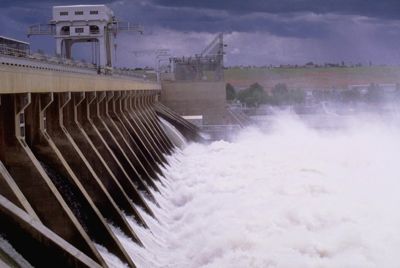forum
library
tutorial
contact

Increasing Salmon Spill at Columbia/Snake Dams:
BPA Economic Analysis says $110 Million Annual Loss
by Staff
Columbia Basin Bulletin, February 21, 2014
|
the film forum library tutorial contact |

|
Increasing Salmon Spill at Columbia/Snake Dams:
by Staff
|
 The Bonneville Power Administration is circulating an analysis of a proposed spring spill test aimed at salmon recovery at Columbia/Snake River dams that suggests that if implemented for 10 years would lead to an annual loss of $110 million per year in power sales.
The Bonneville Power Administration is circulating an analysis of a proposed spring spill test aimed at salmon recovery at Columbia/Snake River dams that suggests that if implemented for 10 years would lead to an annual loss of $110 million per year in power sales.
In December, The Northwest Power and Conservation Council, in a split vote, decided to ask for "independent" scientific advice on whether spill at Columbia and Snake river mainstem dams should be ramped up to see what kind of benefit such hydro operations might bring to migrating salmon and steelhead.
(See CBB, Dec. 12, 1013, "Council Seeks Independent Science Advice On Proposal To Test Increased Spill At Mainstem Dams" www.cbbulletin.com/429268.aspx)
An "experimental spill" plan proposed by the state of Oregon and others suggested that amendments to the Council's Columbia River Fish and Wildlife Program include recommendations that mainstem dams channel more water through spill gates in spring and summer than is now called for by existing court orders and the NOAA Fisheries 2008-2018 Federal Columbia River Power System biological opinion.
The BiOp outlines measures aimed at improving the survival of Columbia River basin salmon and steelhead listed under the Endangered Species Act.
This month, in an e-mail to the Council, Peter T. Cogswell, acting chief public affairs officer for BPA, said:
"We have received inquiries from multiple parties about potential impacts of the proposal and are engaging in conversations about it as interest in these potential impacts has grown. In fact, I know that at least some Council members have already received preliminary reports about the analysis. We therefore wanted to share it with all of you directly and offer to discuss it in more detail as appropriate. In so doing, we want to emphasize that our analysis is preliminary and is based on the proposal as presented in comments on the Draft FCRPS Biological Opinion as well as the NPCC's Fish and Wildlife Program Amendment process.
"For our analysis, we used the same assumptions that we used in modeling for our most recent rate case, with the exception being we modeled the court ordered spill as the base case here. With the court ordered spill as the base case, we then modeled the incremental effects of the proposal calling for spill to 125 percent Total Dissolved Gas levels. We recognize that the proposed 125 percent spill levels were conditioned on potential biological constraints, but our analysis did not take that into account because these potential constraints were not specified in the proposal. Our estimate of lost power is the resulting difference between court-ordered spill and our interpretation of operations under the proposed test.
"Our analysis indicates that the 24x7 spill test to 125 percent Total Dissolved Gas levels for April 3 through June 20 would reduce the value of FCRPS power generation by about $110 million per year. The replacement cost under the terms of the Tiered Rate Methodology could result in an almost 8 percent wholesale power rate increase. There also would be a significant increase in the social cost of carbon to the region, somewhere in the range of another $50 million per year.
"Additionally, operating the river at 125 percent TDG would limit our flexibility to integrate variable resources and may have other operational implications associated with replacement power and transmission that are not yet well understood.
"These numbers are significant and represent our best attempt to put the impacts of the proposal, as we understand it, into some sort of context for interested parties. That said, they are based on BPA's specific method for analyzing this kind of impact to the hydro system over multiple years and we welcome feedback. We also would be happy to discuss our analysis in more detail with you or other interested parties at the appropriate time. Ultimately, we want to be as accurate as possible in informing deliberations about the proposed test."
BPA's analysis says:
The ISAB report was issued today. See CBB story:
"Increasing Salmon Spill At Columbia/Snake Dams; Science Panel Lists Biological Risks To Aquatic Life" www.cbbulletin.com/429790.aspx
The spill experimental proposal says: "Under recent operations and configuration of the Federal Columbia River Power System (FCRPS), smolt-to-adult return rates (SARs) have averaged 0.9 percent for wild spring-summer chinook salmon from the Snake River, well below the Northwest Power and Conservation Council (NPCC) average SAR goal of 4 percent (Tuomikoski et al. 2012)."
Those goals are outlined in the Council's current program, which was approved in 2009.
"In addition, Snake River wild spring-summer chinook salmon have achieved the NPCC minimum SAR goal of 2 percent in only two years out of the seventeen years that have been monitored. Similarly, SARs have averaged 1.6 percent and achieved the 2 percent minimum in only seven of thirteen years for wild steelhead from the Snake River.
"These results indicate that recent operations and configuration of the FCRPS have been insufficient to achieve the regional SAR goals defined by the NPCC," the Oregon proposal says. "As a result, nearly all populations that constitute the Snake River Evolutionarily Significant Units (ESUs) remain at high risk of extinction."
Related Pages:
Increasing Spill at Columbia/Snake Dams: Science Panel Lists Biological Risks to Aquatic Life by Staff, Columbia Basin Bulletin, 2/21/14
Scientists say Oregon's Spill Proposal Not Ready for Prime Time by Bill Rudolph, NW Fishletter, 2/20/14
learn more on topics covered in the film
see the video
read the script
learn the songs
discussion forum
